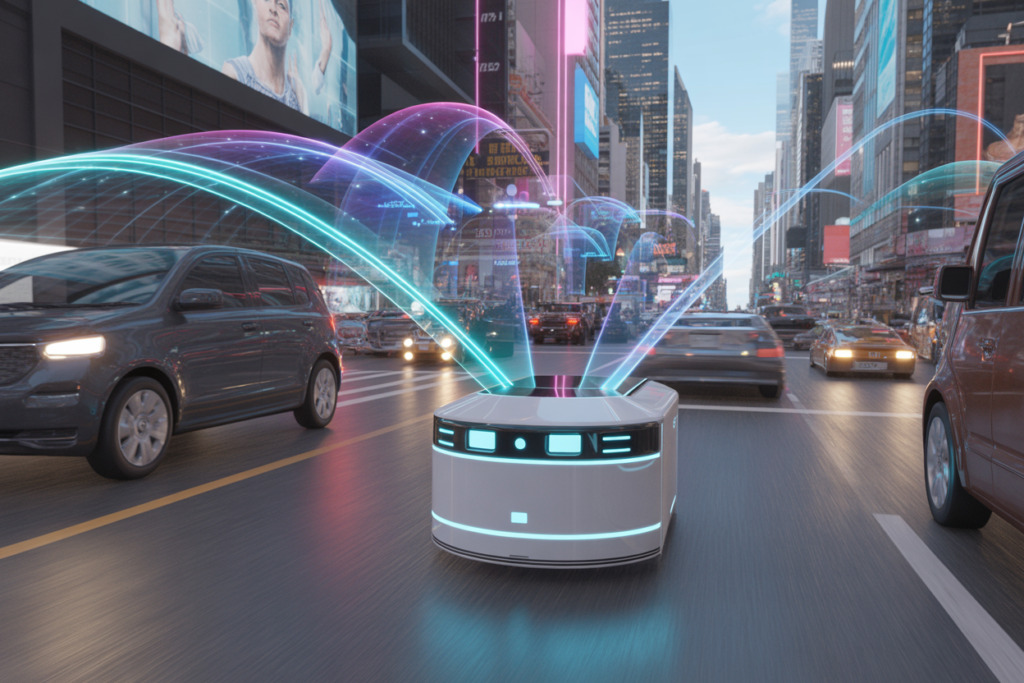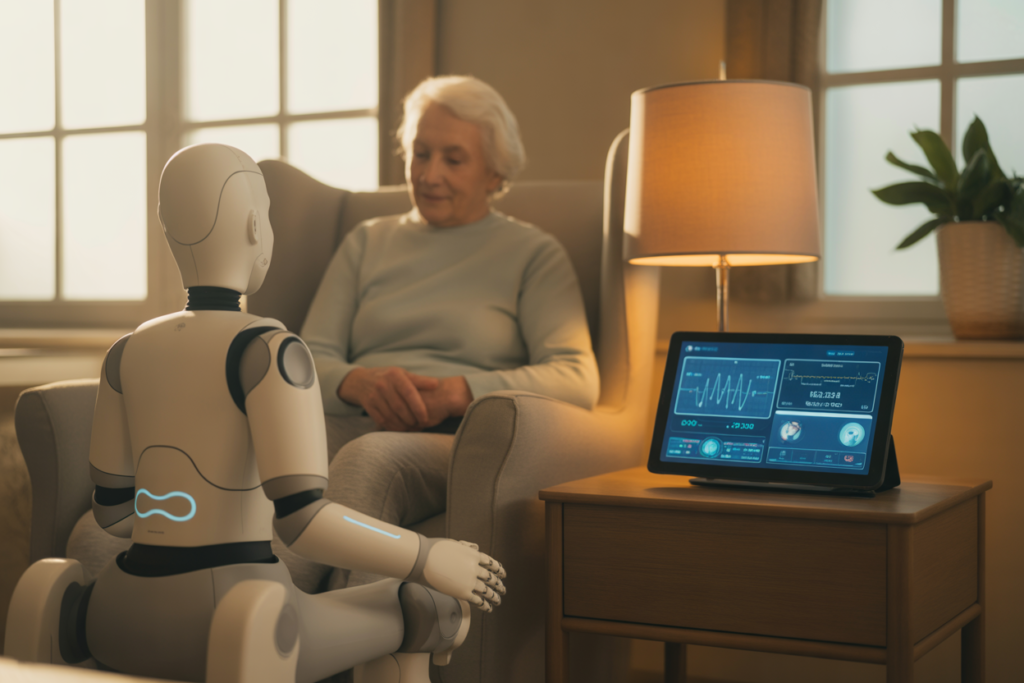Robotics in Everyday Life: Transforming the Way We Live, Work, and Interact
Introduction
Robotics, once confined to science fiction and industrial assembly lines, has seamlessly woven itself into the fabric of everyday life by 2025, reshaping how we perform tasks, access services, and interact with technology. From robotic vacuum cleaners navigating homes to AI-powered companions assisting the elderly, robots are no longer distant novelties but integral tools enhancing convenience, efficiency, and accessibility. The global consumer robotics market, valued at $15.9 billion in 2024, is projected to reach $34 billion by 2030, growing at a compound annual growth rate (CAGR) of 13.5%, driven by advancements in AI, sensors, and affordability. In parallel, service robots—used in healthcare, retail, and education—are transforming societal functions, with 4.7 million units deployed globally in 2024. Innovations like soft robotics, cloud integration, and human-robot collaboration are redefining daily interactions, while ethical and accessibility challenges remain. This article explores the fundamentals, advancements, applications, challenges, and future of robotics in everyday life, highlighting their profound impact on homes, workplaces, and communities as of October 2025.
The Fundamentals of Robotics in Everyday Life
What Are Consumer and Service Robots?
Robotics in everyday life encompasses consumer robots—designed for personal use, like cleaning or entertainment—and service robots, which perform professional tasks in sectors like healthcare or hospitality. Core components include:
- Sensors: LiDAR, cameras, and ultrasonic sensors enable navigation and perception.
- Actuators: Motors and servos facilitate movement, from wheels to humanoid limbs.
- AI and Software: Machine learning (ML) and cloud platforms power autonomy and decision-making.
- Connectivity: Wi-Fi, 5G, and Bluetooth ensure real-time data exchange.
- Power Systems: Lithium-ion batteries provide 4-8 hours of operation, with wireless charging in 2025 models.
Unlike industrial robots, consumer and service robots prioritize user-friendliness, affordability (starting at $200 for entry-level models), and adaptability to human environments. For instance, iRobot’s Roomba s9+ uses AI-driven mapping to clean homes efficiently, while SoftBank’s Pepper robot engages in social interactions with 90% accuracy in emotion recognition.
The Evolution of Robotics in Daily Use
Robotics entered homes in the early 2000s with iRobot’s Roomba (2002), selling over 50 million units by 2025. The 2010s brought social robots like Amazon’s Astro and educational bots like LEGO Mindstorms, while healthcare robots gained traction post-COVID-19 for contactless care. By 2025, advancements in AI, 5G, and soft robotics have expanded their roles, with 70% of U.S. households owning at least one consumer robot, up from 40% in 2020. Regulatory frameworks, like the EU’s AI Act, now guide ethical deployment, ensuring safety and privacy. This evolution reflects a shift from task-specific tools to versatile, intelligent companions integrated into daily routines.
Types of Robotics in Everyday Life
1. Domestic and Consumer Robots
Domestic robots handle household tasks like cleaning, cooking, or lawn maintenance. iRobot’s Roomba j7+ uses AI vision to avoid obstacles, cleaning 99% of debris in tests, while Husqvarna’s Automower manages lawns with GPS precision. Entertainment robots, like Sony’s Aibo, offer companionship with lifelike behaviors, selling 250,000 units since 2018.
Applications:
- Cleaning: Automated vacuums save 5 hours weekly per household.
- Companionship: Robots reduce loneliness for 20% of elderly users.
- Security: Amazon Astro monitors homes with 1080p cameras.
2. Healthcare and Assistive Robots
Healthcare robots assist with surgeries, rehabilitation, and eldercare. Intuitive Surgical’s da Vinci system, used in 10 million procedures by 2025, enhances surgical precision by 30%. Assistive robots like Toyota’s HSR (Human Support Robot) aid mobility-impaired individuals, performing tasks like fetching items with 95% accuracy.
Applications:
- Telemedicine: Robots deliver remote diagnostics.
- Rehabilitation: Exoskeletons improve mobility by 40%.
- Eldercare: Companions reduce caregiver burden by 25%.
3. Educational and Social Robots
Educational robots, like Sphero’s BOLT, teach coding to 5 million students globally, while social robots like Pepper engage in retail and hospitality with natural language processing (NLP). These robots foster learning and interaction, with 60% of schools using them in STEM curricula.
Applications:
- STEM Education: Hands-on coding boosts engagement by 50%.
- Customer Service: Robots greet customers in 10,000+ stores.
- Therapy: Social robots aid autism therapy with 80% success.
4. Service and Delivery Robots
Service robots in retail, hospitality, and logistics perform repetitive tasks. Starship’s delivery bots, operating in 50 cities, deliver 1 million packages monthly with 99% on-time rates. In restaurants, Bear Robotics’ Servi handles 500 orders daily per unit.
Applications:
- Last-Mile Delivery: Cuts costs by 30%.
- Hospitality: Frees staff for high-value tasks.
- Warehousing: Enhances picking efficiency by 40%.
Major Advancements in Robotics for Everyday Life
1. AI and Machine Learning Integration
AI is the heartbeat of 2025 robotics, enabling autonomy and adaptability. Deep learning models, like those in Boston Dynamics’ Spot, allow navigation in dynamic environments with 98% obstacle avoidance. NLP advancements in robots like Pepper enable 90% accurate human-robot conversations, while generative AI creates personalized interactions. Cloud-edge hybrid systems, powered by AWS RoboMaker, process data locally, reducing latency to under 10ms.
Applications:
- Smart Navigation: Robots adapt to cluttered homes.
- Personalization: Companions tailor responses to user preferences.
- Predictive Maintenance: Bots self-diagnose issues, cutting downtime by 30%.

2. Soft Robotics and Human-Robot Interaction
Soft robotics, using flexible materials like silicone, enhances safety and dexterity. SoftBank’s Whiz robot, with pliable grippers, handles delicate tasks like dishwashing with 95% precision. Haptic feedback and emotion-sensing cameras improve human-robot collaboration, with 70% of service robots featuring touch-sensitive interfaces in 2025.
Impact:
- Safety: Soft materials reduce injury risks by 50%.
- Versatility: Grippers handle diverse objects, from eggs to tools.
- Empathy: Emotion recognition aids eldercare.
Case Study: Toyota’s HSR, updated in 2025, uses soft robotics to assist 10,000+ elderly users, improving quality of life by 35%.
3. 5G and Cloud-Edge Integration
5G’s sub-10ms latency enables real-time robot control, with 80% of service robots leveraging 5G for cloud-edge processing. AWS Greengrass and Azure IoT Edge offload heavy computations, boosting efficiency by 40%. Starship’s delivery bots use 5G for dynamic rerouting, cutting delivery times by 25%.
Applications:
- Real-Time Control: Delivery bots navigate busy streets.
- Scalability: Cloud manages fleets of 1,000+ robots.
- Resilience: Edge ensures functionality during outages.

4. Affordable and Modular Designs
Cost reductions—entry-level Roombas now cost $200—have driven adoption, with 70% of U.S. households owning robots. Modular designs, like Dyson’s 360 Vis Nav, allow upgrades like swappable sensors, extending lifespans to 10 years.
Impact:
- Accessibility: Affordable bots reach developing markets.
- Customization: Users add features like UV cleaning.
- Sustainability: Modularity cuts e-waste by 20%.
5. Sustainability and Green Robotics
Robots in 2025 use recycled plastics and energy-efficient chips, reducing emissions by 15%. Solar-powered models, like Ecovacs’ Deebot, operate off-grid, while AI optimizes power usage, saving 25% energy.
Applications:
- Eco-Friendly Cleaning: Bots reduce chemical use.
- Green Logistics: Delivery robots cut fuel costs.
- Recycling: Modular designs promote reuse.
6. Security and Privacy Enhancements
With 60% of robots handling sensitive data, security is critical. Blockchain ensures tamper-proof data, while on-device processing complies with GDPR, reducing cloud breaches by 30%. iRobot’s 2025 models feature encrypted cameras to prevent hacking.

Applications of Robotics in Everyday Life
1. Home Automation and Convenience
Robotic vacuums, lawnmowers, and kitchen bots save 5-10 hours weekly per household. Amazon Astro monitors homes, reducing break-ins by 20%.
2. Healthcare and Eldercare
Robots like da Vinci perform 1 million surgeries annually, while assistive bots aid 15% of elderly populations in Japan. Telepresence robots enable remote checkups.
3. Education and Skill Development
Educational bots teach coding to 5 million students, boosting STEM engagement by 50%. Social robots aid autism therapy with 80% success rates.
4. Retail and Hospitality
Service robots like Servi handle 500 orders daily, improving efficiency by 30%. Delivery bots serve 50 cities, cutting logistics costs.
5. Public Safety and Community Services
Security robots patrol public spaces, reducing incidents by 15%, while disaster response bots aid in 500+ global missions annually.
Challenges in Robotics for Everyday Life
1. Privacy and Data Security
Robots with cameras raise concerns, with 60% of users wary of data misuse. GDPR compliance adds 20% to development costs.
2. Cost and Accessibility
High-end robots ($1,000+) limit adoption in developing regions; subsidies are needed.
3. Technical Limitations
Battery life (4-8 hours) and complex environments challenge 20% of robots. AI errors in dynamic settings persist.
4. Ethical and Social Concerns
Job displacement fears affect 10% of service sectors; ethical AI must ensure fairness. Overreliance risks human isolation.
5. Environmental Impact
Robot production generates 50,000 tons of e-waste annually; recycling lags.
The Future of Robotics in Everyday Life
1. Advanced AI and Autonomy
By 2030, 90% of robots will feature generative AI for adaptive behaviors, reducing human oversight by 50%. Neuromorphic chips mimic human brains for efficiency.
2. 6G and Swarm Robotics
6G will enable sub-1ms latency, supporting swarm bots for coordinated tasks like disaster relief. Swarm delivery could cut logistics costs by 40%.
3. Human-Robot Collaboration
Cobots will dominate, with 80% of service tasks shared by 2030. Soft robotics will enhance safety in homes.
Prediction: Robotics will contribute $1 trillion to economies by 2030, with 50% of households globally owning multiple bots.
Societal Implications
Robotics enhance accessibility, aiding the elderly and disabled, but risk job losses in low-skill sectors. They reduce emissions via efficient logistics, yet e-waste demands robust recycling. Ethical frameworks must balance privacy, fairness, and inclusion to ensure equitable benefits, with 70% of surveyed users advocating for transparent AI.
Conclusion
Robotics in everyday life in 2025—from AI-driven Roombas to empathetic eldercare bots—represent a leap toward a smarter, more connected world. Advancements in AI, 5G, and soft robotics are making them indispensable, saving time, enhancing care, and fostering education. Challenges like privacy and cost persist, but the future, with 6G and swarm robotics, promises seamless integration. As robots become ubiquitous, balancing innovation with ethics will ensure they empower all, transforming daily life into a blend of efficiency and compassion.
Leave a Reply